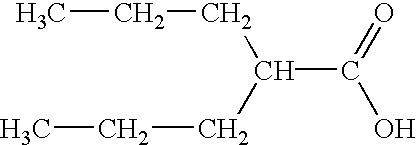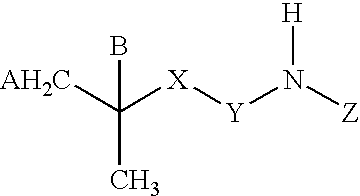Solid dosage forms of divalproex sodium
- Summary
- Abstract
- Description
- Claims
- Application Information
AI Technical Summary
Benefits of technology
Problems solved by technology
Method used
Image
Examples
example 1
[0077] Prior to use, divalproex sodium was reduced to small particles through a band (0.59 mm nominal mesh opening) with impact forward using a Fitzmill. The milled divalproex sodium is charged along with excipients (povidone K30, sodium starch glycolate, microcrystalline cellulose or dicalcium phosphate) into a Collette Gral 10 high shear mixer. The material is dry mixed for 5 min at low impeller speed. (200 rpm). The material then is wet massed with a 0.1 N citric acid solution as the granulation fluid at a high chopper speed (3000 rpm) and high impeller speed. (500 rpm) until granulation is complete. The material is dried in a fluid bed dryer to an LOD of not more than 2.0%. The dried granulation is milled through a band (0.84 mm nominal mesh opening) with knife forward using a Fitzmill. The milled material is added to a V-blender with silicon dioxide (Syloid 244) and blended until uniform. The resulted blend is compressed on a rotary tablet press into 720 mg tablets that contain...
example
[0078] Prior to use, divalproex sodium was reduced to small particles through a band (20 mesh) with impact forward using a Fitzmill. The milled divalproex sodium is charged along with ith excipients (povidone K30, Prosolv 50 or 90) into a Collette Gral 10 high shear mixer. The material is dry mixed for 5 min at low impeller speed. (200 rpm). The material then is wet massed with a 20 to 30% PVP solution (w / w, in 0.1 N citric acid) as the granulation fluid at a high chopper speed (3000 rpm) and high impeller speed. (500 rpm) until granulation is complete. The material is dried in a fluid bed dryer to an LOD of not more than 2.0%. The dried granulation is milled through a band (16 mesh) with impact forward using a Fitzmill. The milled material is added to a V-blender with silicon dioxide (syloid 244) and blended until uniform. The resulted blend is compressed on a rotary tablet press into 670 to 720 mg tablets that contain 500 mg valproic acid equivalent or 1010 to 1080 mg tablets that...
example 3
[0081] This example illustrates the results of in vitro dissolution testing on a dosage form prepared using the methods described above in Example 1 and 2.
In vitro dissolution test
[0082] In vitro dissolution rate of the tablets were compared with that of the reference, depakote, the uncoated marketed tablet, which contains the same amount of the active ingredient. USP apparatus II was used for testing. The test condition was: paddle speed=50 rpm; dissolution medium=900 ml 0.5M phosphate buffer at pH 7.5; temperature=37.degree. C. Dissolution samples were analyzed by a TDX fluorescence-polarized immunoassay.
Results and Discussions
[0083] In vitro dissolution profiles of the reference tablet and tablet from the current invention shown in FIG. 1 indicate that dissolution of the current invention is rapid, complete and equivalent to the reference (>90% in 20 minutes). Because divalproex sodium is a soluble, permeable and stable compound and known to have complete oral absorption, equival...
PUM
| Property | Measurement | Unit |
|---|---|---|
| Fraction | aaaaa | aaaaa |
| Fraction | aaaaa | aaaaa |
| Fraction | aaaaa | aaaaa |
Abstract
Description
Claims
Application Information
 Login to View More
Login to View More - R&D
- Intellectual Property
- Life Sciences
- Materials
- Tech Scout
- Unparalleled Data Quality
- Higher Quality Content
- 60% Fewer Hallucinations
Browse by: Latest US Patents, China's latest patents, Technical Efficacy Thesaurus, Application Domain, Technology Topic, Popular Technical Reports.
© 2025 PatSnap. All rights reserved.Legal|Privacy policy|Modern Slavery Act Transparency Statement|Sitemap|About US| Contact US: help@patsnap.com



